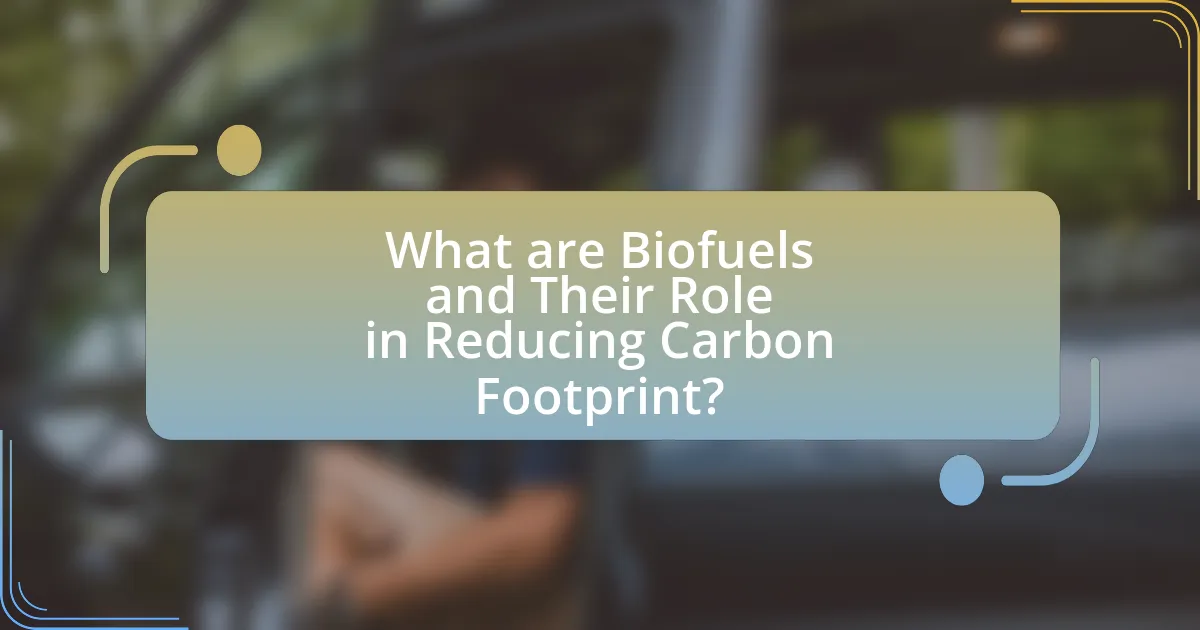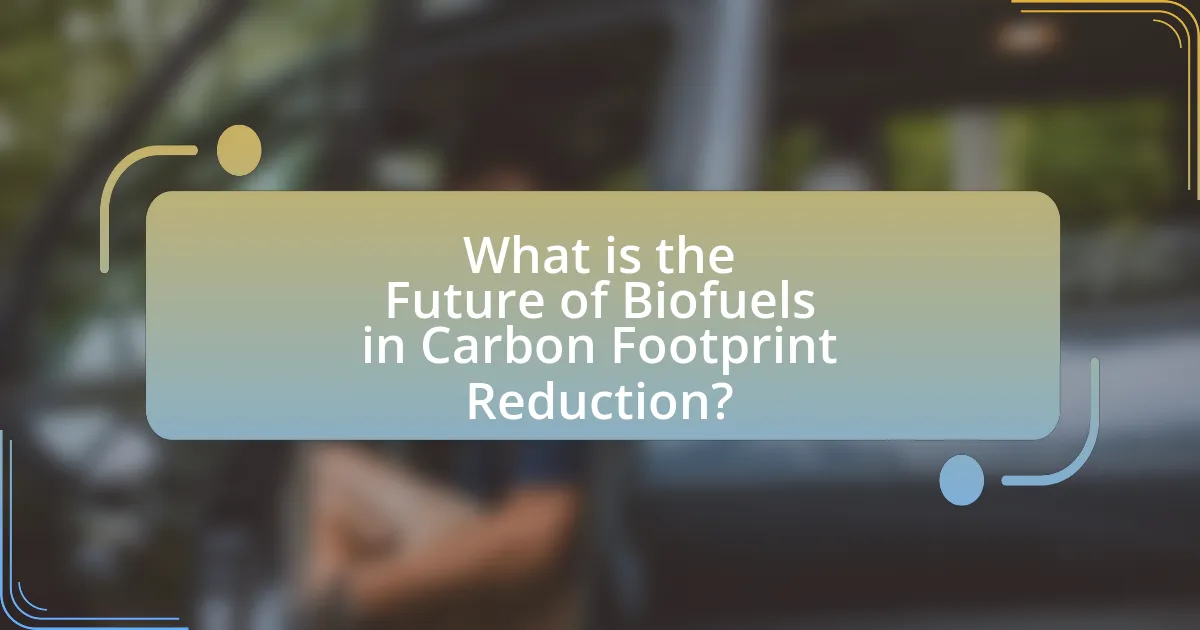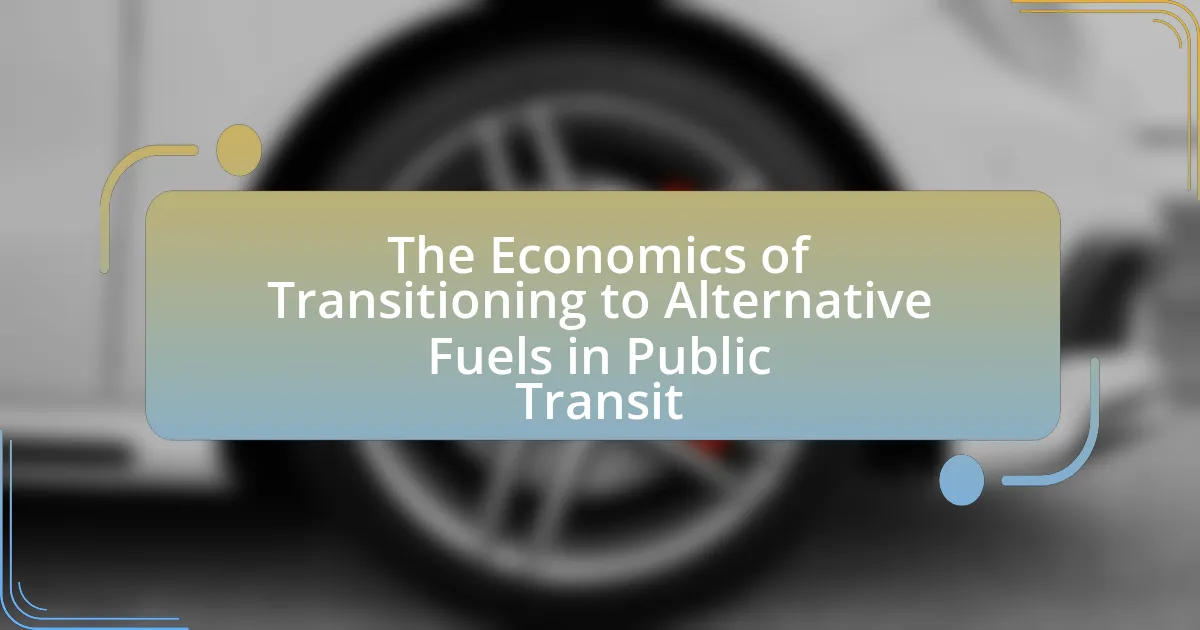Biofuels are renewable energy sources derived from organic materials, playing a crucial role in reducing carbon footprints by lowering greenhouse gas emissions compared to fossil fuels. The article explores how biofuels contribute to carbon footprint reduction, highlighting their effectiveness in mitigating climate change through a closed carbon cycle. It discusses various types of biofuels, including first, second, and third-generation biofuels, and examines their production processes, advantages, and challenges. Additionally, the article addresses the economic implications, environmental impacts, and the role of policies and technology in advancing biofuel adoption, ultimately emphasizing their potential in achieving climate goals and transitioning to a sustainable energy future.

What are Biofuels and Their Role in Reducing Carbon Footprint?
Biofuels are renewable energy sources derived from organic materials, such as plants and animal waste, that can be used as alternatives to fossil fuels. Their role in reducing carbon footprint is significant, as they can lower greenhouse gas emissions when compared to traditional fossil fuels. For instance, according to the U.S. Department of Energy, biofuels can reduce carbon dioxide emissions by up to 86% compared to gasoline. This reduction occurs because biofuels are produced from biomass that absorbs carbon dioxide during its growth, creating a closed carbon cycle. Thus, the use of biofuels contributes to mitigating climate change by decreasing reliance on fossil fuels and lowering overall carbon emissions.
How do biofuels contribute to carbon footprint reduction?
Biofuels contribute to carbon footprint reduction by providing a renewable energy source that emits significantly lower greenhouse gases compared to fossil fuels. When biofuels are burned, they release carbon dioxide that was previously absorbed by the plants during their growth, creating a closed carbon cycle. For instance, studies show that biofuels can reduce greenhouse gas emissions by up to 80% compared to traditional gasoline, depending on the feedstock and production methods used. This reduction is further supported by the U.S. Environmental Protection Agency, which recognizes that biofuels can play a crucial role in achieving climate goals by displacing fossil fuel consumption.
What types of biofuels are most effective in reducing carbon emissions?
Advanced biofuels, particularly those derived from waste materials and non-food crops, are most effective in reducing carbon emissions. These biofuels, such as cellulosic ethanol and biodiesel from algae, can achieve significant greenhouse gas reductions compared to traditional fossil fuels. For instance, cellulosic ethanol can reduce carbon emissions by up to 86% compared to gasoline, according to the U.S. Department of Energy. Additionally, biodiesel produced from algae can sequester carbon dioxide during its growth, further enhancing its carbon reduction potential.
How do biofuels compare to fossil fuels in terms of carbon output?
Biofuels generally produce lower carbon output compared to fossil fuels. When burned, biofuels release carbon dioxide that was previously absorbed by the plants during their growth, creating a closed carbon cycle. In contrast, fossil fuels release carbon that has been stored underground for millions of years, contributing to a net increase in atmospheric carbon levels. Studies indicate that biofuels can reduce greenhouse gas emissions by up to 80% compared to conventional fossil fuels, depending on the type of biofuel and production methods used. For example, a report by the U.S. Department of Energy highlights that using biodiesel can result in a 78% reduction in lifecycle greenhouse gas emissions compared to petroleum diesel.
Why is reducing carbon footprint important?
Reducing carbon footprint is important because it directly mitigates climate change and its associated impacts on ecosystems and human health. The carbon footprint represents the total greenhouse gas emissions caused by an individual, organization, or product, and reducing it can significantly lower global warming potential. According to the Intergovernmental Panel on Climate Change (IPCC), limiting global temperature rise to 1.5 degrees Celsius requires a substantial reduction in carbon emissions, which can be achieved through sustainable practices, including the use of biofuels. Biofuels can replace fossil fuels, leading to lower carbon emissions during energy production and consumption, thus playing a crucial role in achieving climate targets.
What are the environmental impacts of high carbon emissions?
High carbon emissions significantly contribute to climate change, leading to severe environmental impacts. These emissions increase atmospheric concentrations of carbon dioxide, which is a primary greenhouse gas, resulting in global warming. According to the Intergovernmental Panel on Climate Change (IPCC), the Earth’s average temperature has risen by approximately 1.1 degrees Celsius since the late 19th century due to human activities, primarily fossil fuel combustion. This warming causes more frequent and intense weather events, such as hurricanes, droughts, and floods, disrupting ecosystems and biodiversity. Additionally, high carbon emissions lead to ocean acidification, as excess CO2 is absorbed by oceans, harming marine life and coral reefs. The World Resources Institute reports that these environmental changes threaten food security, water resources, and human health, underscoring the urgent need to reduce carbon emissions through sustainable practices, including the adoption of biofuels.
How does carbon footprint reduction affect climate change?
Reducing carbon footprint directly mitigates climate change by decreasing greenhouse gas emissions, which are the primary drivers of global warming. When individuals and organizations lower their carbon emissions through practices such as using biofuels, they contribute to a reduction in atmospheric carbon dioxide levels. For instance, the use of biofuels can lead to a decrease in lifecycle greenhouse gas emissions by up to 80% compared to fossil fuels, as reported by the U.S. Department of Energy. This reduction helps stabilize global temperatures and minimizes the adverse effects of climate change, such as extreme weather events and rising sea levels.
What are the challenges associated with biofuels?
The challenges associated with biofuels include competition for land, resource intensity, and greenhouse gas emissions during production. Competition for land arises as biofuel crops can displace food crops, leading to food security concerns; for instance, the cultivation of corn for ethanol has been linked to rising food prices. Resource intensity refers to the significant water and energy inputs required for biofuel production, which can strain local resources. Additionally, while biofuels are often considered renewable, their production can still result in greenhouse gas emissions, particularly from land-use changes and agricultural practices, undermining their potential benefits in reducing carbon footprints.
What are the economic implications of biofuel production?
Biofuel production has significant economic implications, including job creation, shifts in agricultural markets, and impacts on energy prices. The biofuel industry generates employment opportunities in farming, processing, and distribution, with the U.S. biofuel sector supporting over 1.5 million jobs as of 2021. Additionally, the demand for biofuel feedstocks, such as corn and soybeans, influences agricultural prices and land use, often leading to increased competition for resources between food and fuel production. Furthermore, biofuels can affect energy prices by providing an alternative to fossil fuels, potentially stabilizing or lowering costs in volatile oil markets. These economic factors illustrate the multifaceted impact of biofuel production on both local and global economies.
How do land use changes impact the effectiveness of biofuels?
Land use changes significantly impact the effectiveness of biofuels by altering the availability of feedstock and influencing carbon emissions. When agricultural land is converted for biofuel production, it can lead to competition with food crops, potentially increasing food prices and affecting food security. Additionally, land use changes can result in the release of stored carbon in soils and vegetation, negating the carbon savings that biofuels aim to achieve. For instance, a study published in “Nature Climate Change” by Searchinger et al. (2018) found that converting forests or grasslands to biofuel crops can release more carbon than the biofuels save over their lifecycle. Thus, the effectiveness of biofuels is closely tied to how land is utilized and managed.
How can biofuels be integrated into existing energy systems?
Biofuels can be integrated into existing energy systems by blending them with conventional fuels, utilizing them in dedicated biofuel infrastructure, and adapting existing engines and power plants for biofuel use. Blending biofuels, such as biodiesel or ethanol, with diesel or gasoline allows for immediate use in current vehicles without significant modifications, as seen in countries like Brazil, where ethanol is blended with gasoline at varying ratios. Additionally, dedicated biofuel infrastructure, including production facilities and distribution networks, can be developed to support large-scale biofuel deployment. Furthermore, retrofitting existing engines and power plants to accommodate biofuels enhances their compatibility, as demonstrated by studies showing that many diesel engines can operate efficiently on biodiesel blends. These methods collectively facilitate the transition to biofuels, contributing to a reduction in carbon emissions and reliance on fossil fuels.
What innovations are driving the biofuel industry forward?
Innovations driving the biofuel industry forward include advanced feedstock development, improved conversion technologies, and enhanced sustainability practices. Advanced feedstock development focuses on utilizing non-food crops and waste materials, which reduces competition with food supply and enhances resource efficiency. Improved conversion technologies, such as enzymatic hydrolysis and gasification, increase the yield and efficiency of biofuel production, making it more economically viable. Enhanced sustainability practices, including life cycle assessments and carbon accounting, ensure that biofuels contribute positively to reducing carbon footprints. For instance, the U.S. Department of Energy reports that second-generation biofuels can reduce greenhouse gas emissions by up to 80% compared to fossil fuels, demonstrating the significant impact of these innovations on the industry.

What are the Different Types of Biofuels?
The different types of biofuels include first-generation biofuels, second-generation biofuels, and third-generation biofuels. First-generation biofuels are derived from food crops, such as corn and sugarcane, and are commonly used in transportation fuels like ethanol and biodiesel. Second-generation biofuels are produced from non-food biomass, including agricultural residues and dedicated energy crops, which helps to avoid food supply issues. Third-generation biofuels are derived from algae, which can produce high yields of oil and have the potential to significantly reduce greenhouse gas emissions. According to the International Energy Agency, biofuels accounted for about 3% of global transport fuel in 2020, highlighting their growing role in reducing carbon footprints.
What are first-generation biofuels?
First-generation biofuels are fuels produced directly from food crops, such as corn, sugarcane, and vegetable oils. These biofuels are primarily derived through processes like fermentation and transesterification, converting biomass into ethanol or biodiesel. For instance, in the United States, corn is fermented to produce ethanol, which accounted for approximately 10% of the total gasoline supply in 2020, according to the U.S. Energy Information Administration. This demonstrates the significant role first-generation biofuels play in the energy sector while also highlighting their reliance on agricultural resources.
How are first-generation biofuels produced?
First-generation biofuels are produced primarily from food crops such as corn, sugarcane, and vegetable oils. The production process involves the fermentation of sugars or starches from these crops to create ethanol or the extraction of oils to produce biodiesel. For instance, corn is processed to extract starch, which is then fermented by yeast to produce ethanol, while vegetable oils undergo transesterification to yield biodiesel. This method of biofuel production is well-established and has been widely implemented, contributing to the renewable energy sector and reducing reliance on fossil fuels.
What are the advantages and disadvantages of first-generation biofuels?
First-generation biofuels offer advantages such as reduced greenhouse gas emissions compared to fossil fuels and the potential for energy security through domestic production. These biofuels, derived from food crops like corn and sugarcane, can lower carbon footprints by approximately 30% to 90% depending on the production process and feedstock used. However, they also have significant disadvantages, including competition with food supply, which can lead to higher food prices and food insecurity. Additionally, the cultivation of these crops can result in land-use changes that may contribute to deforestation and biodiversity loss. Thus, while first-generation biofuels can contribute to carbon footprint reduction, they also pose challenges that must be addressed.
What are second-generation biofuels?
Second-generation biofuels are renewable energy sources produced from non-food biomass, such as agricultural residues, wood chips, and dedicated energy crops. These biofuels differ from first-generation biofuels, which are derived from food crops like corn and sugarcane, thereby reducing competition for food resources. Second-generation biofuels utilize lignocellulosic materials, which are more abundant and can be converted into fuels through advanced technologies like enzymatic hydrolysis and fermentation. This approach not only enhances energy security but also contributes to lower greenhouse gas emissions, as they can achieve up to 90% reduction in carbon footprint compared to fossil fuels.
How do second-generation biofuels differ from first-generation?
Second-generation biofuels differ from first-generation biofuels primarily in their feedstock sources and production processes. First-generation biofuels are derived from food crops such as corn, sugarcane, and vegetable oils, which can compete with food supply and contribute to food price increases. In contrast, second-generation biofuels utilize non-food biomass, including agricultural residues, forestry waste, and dedicated energy crops, which do not compete with food resources. This shift not only enhances sustainability but also reduces the carbon footprint associated with land use changes and food production. Studies indicate that second-generation biofuels can achieve up to 90% reduction in greenhouse gas emissions compared to fossil fuels, making them a more environmentally friendly alternative.
What feedstocks are used for second-generation biofuels?
Second-generation biofuels utilize non-food feedstocks, primarily lignocellulosic biomass, which includes agricultural residues, forestry residues, and dedicated energy crops. These feedstocks are advantageous because they do not compete with food production and can significantly reduce greenhouse gas emissions compared to fossil fuels. For instance, according to the U.S. Department of Energy, using lignocellulosic materials can lead to a reduction of up to 90% in lifecycle greenhouse gas emissions compared to conventional gasoline.
What are third-generation biofuels?
Third-generation biofuels are advanced biofuels produced from non-food biomass, primarily algae and other aquatic organisms. These biofuels are considered sustainable because they do not compete with food crops for land and resources, thus minimizing the impact on food supply. Research indicates that algae can produce significantly higher yields of oil compared to traditional crops, with some estimates suggesting that algae can yield up to 30 times more oil per acre than soybeans. This high productivity, combined with the ability of algae to absorb carbon dioxide during growth, positions third-generation biofuels as a promising solution for reducing carbon emissions and addressing climate change.
What technologies are involved in producing third-generation biofuels?
Third-generation biofuels are produced using technologies such as algae cultivation, fermentation, and transesterification. Algae cultivation involves growing microalgae that can convert sunlight and carbon dioxide into biomass, which can then be processed into biofuels. Fermentation technology is utilized to convert sugars derived from biomass into ethanol or other biofuels, while transesterification is a chemical process that transforms oils or fats into biodiesel. These technologies are validated by studies indicating that algae can produce up to 30 times more oil per acre than traditional crops, making them a highly efficient source for biofuel production.
How do third-generation biofuels impact sustainability?
Third-generation biofuels significantly enhance sustainability by utilizing non-food biomass, such as algae, which do not compete with food crops for land and resources. This approach reduces land-use change and associated carbon emissions, as algae can be cultivated on marginal lands and require less freshwater compared to traditional crops. Furthermore, third-generation biofuels can achieve higher energy yields per acre, with some algae species producing up to 30 times more oil than conventional oilseed crops. This efficiency contributes to a lower carbon footprint, as the lifecycle emissions from production to combustion are minimized. Studies indicate that algae-based biofuels can reduce greenhouse gas emissions by up to 80% compared to fossil fuels, reinforcing their role in sustainable energy solutions.

What is the Future of Biofuels in Carbon Footprint Reduction?
The future of biofuels in carbon footprint reduction is promising, as advancements in technology and sustainable practices enhance their viability. Biofuels, derived from organic materials, can significantly lower greenhouse gas emissions compared to fossil fuels; for instance, studies indicate that biofuels can reduce carbon emissions by up to 80% when produced sustainably. Furthermore, innovations in second and third-generation biofuels, such as those derived from waste materials and algae, are expected to improve efficiency and reduce land-use competition. The global push for renewable energy sources, supported by policies and incentives, further solidifies the role of biofuels in achieving climate goals and transitioning to a low-carbon economy.
How are policies shaping the biofuel industry?
Policies are significantly shaping the biofuel industry by establishing regulations, incentives, and mandates that promote the production and use of biofuels. For instance, the Renewable Fuel Standard (RFS) in the United States mandates a certain volume of renewable fuel to be blended into the transportation fuel supply, driving demand for biofuels. Additionally, government subsidies and tax credits for biofuel production lower costs and encourage investment in biofuel technologies. According to the International Energy Agency, biofuels accounted for approximately 3% of global transport fuel in 2020, influenced by supportive policies that aim to reduce greenhouse gas emissions and enhance energy security. These policies not only foster innovation in biofuel production but also help integrate biofuels into the broader energy landscape, thereby contributing to efforts in reducing the carbon footprint.
What regulations are in place to promote biofuel use?
Regulations promoting biofuel use include the Renewable Fuel Standard (RFS) in the United States, which mandates a certain volume of renewable fuel to be blended into the transportation fuel supply. The RFS aims to reduce greenhouse gas emissions and enhance energy security by increasing the use of biofuels. Additionally, the European Union’s Renewable Energy Directive (RED) sets binding targets for renewable energy, including biofuels, in member states, requiring a minimum percentage of renewable energy in transport fuels. These regulations are supported by studies indicating that biofuels can significantly lower carbon emissions compared to fossil fuels, thus contributing to climate change mitigation efforts.
How do government incentives affect biofuel production?
Government incentives significantly boost biofuel production by providing financial support and regulatory frameworks that encourage investment in renewable energy sources. For instance, subsidies and tax credits lower the cost of production, making biofuels more competitive with fossil fuels. According to the U.S. Energy Information Administration, the Renewable Fuel Standard mandates a certain volume of renewable fuel to be blended into transportation fuel, which directly stimulates biofuel production. Additionally, research from the International Renewable Energy Agency indicates that countries with strong government incentives, such as Brazil and the United States, have seen substantial increases in biofuel output, demonstrating the effectiveness of these policies in promoting sustainable energy solutions.
What role does technology play in advancing biofuels?
Technology plays a crucial role in advancing biofuels by enhancing production efficiency and improving feedstock conversion processes. Innovations such as genetic engineering, which modifies microorganisms to increase their ability to convert biomass into biofuels, have significantly boosted yield rates. For instance, research from the National Renewable Energy Laboratory indicates that advanced fermentation techniques can increase ethanol production from cellulosic materials by up to 50%. Additionally, developments in catalytic processes enable the conversion of a wider range of feedstocks, including agricultural waste, into high-quality biofuels, thereby reducing reliance on fossil fuels and lowering greenhouse gas emissions. These technological advancements not only optimize biofuel production but also contribute to a more sustainable energy landscape.
What innovations are being developed to improve biofuel efficiency?
Innovations being developed to improve biofuel efficiency include advanced genetic engineering of microorganisms, which enhances their ability to convert biomass into biofuels more effectively. For instance, researchers are utilizing CRISPR technology to modify yeast and bacteria strains, increasing their tolerance to high sugar concentrations and improving fermentation rates. Additionally, the development of second and third-generation biofuels, derived from non-food feedstocks like agricultural waste and algae, is gaining traction, as these sources can yield higher energy outputs while minimizing competition with food production. Studies indicate that algae can produce up to 30 times more oil per acre than traditional crops, significantly boosting biofuel yield.
How can biotechnology enhance biofuel production?
Biotechnology can enhance biofuel production by optimizing the metabolic pathways of microorganisms and plants to increase the yield of biofuels. Genetic engineering techniques, such as CRISPR and synthetic biology, allow for the modification of organisms to produce higher quantities of biofuels like ethanol and biodiesel from biomass. For instance, research has shown that engineered yeast strains can convert sugars into ethanol more efficiently, achieving yields that are 30% higher than traditional strains. Additionally, biotechnology enables the development of feedstocks that are more resilient and productive, such as drought-resistant crops, which can thrive in various environmental conditions, thereby increasing the overall biomass available for biofuel production.
What practical steps can individuals take to support biofuels?
Individuals can support biofuels by choosing to use biofuel-powered vehicles or equipment. By opting for vehicles that run on biodiesel or ethanol, individuals contribute to the demand for biofuels, which can reduce reliance on fossil fuels. Additionally, individuals can advocate for policies that promote biofuel production and use, such as supporting local legislation that incentivizes biofuel development. Engaging in community initiatives that focus on sustainable energy sources also helps raise awareness and support for biofuels. Furthermore, individuals can educate themselves and others about the benefits of biofuels, including their potential to lower greenhouse gas emissions, as studies show that biofuels can reduce carbon emissions by up to 80% compared to traditional fossil fuels.
How can businesses effectively incorporate biofuels into their operations?
Businesses can effectively incorporate biofuels into their operations by integrating them as a primary energy source for transportation and heating. This transition can be achieved through the adoption of biofuel blends in existing engines and heating systems, which can reduce greenhouse gas emissions significantly. For instance, using biodiesel can lower carbon emissions by up to 78% compared to traditional diesel, according to the U.S. Department of Energy. Additionally, companies can invest in infrastructure for biofuel production and distribution, ensuring a consistent supply chain. Implementing training programs for employees on biofuel usage and benefits can further enhance operational efficiency and sustainability.





